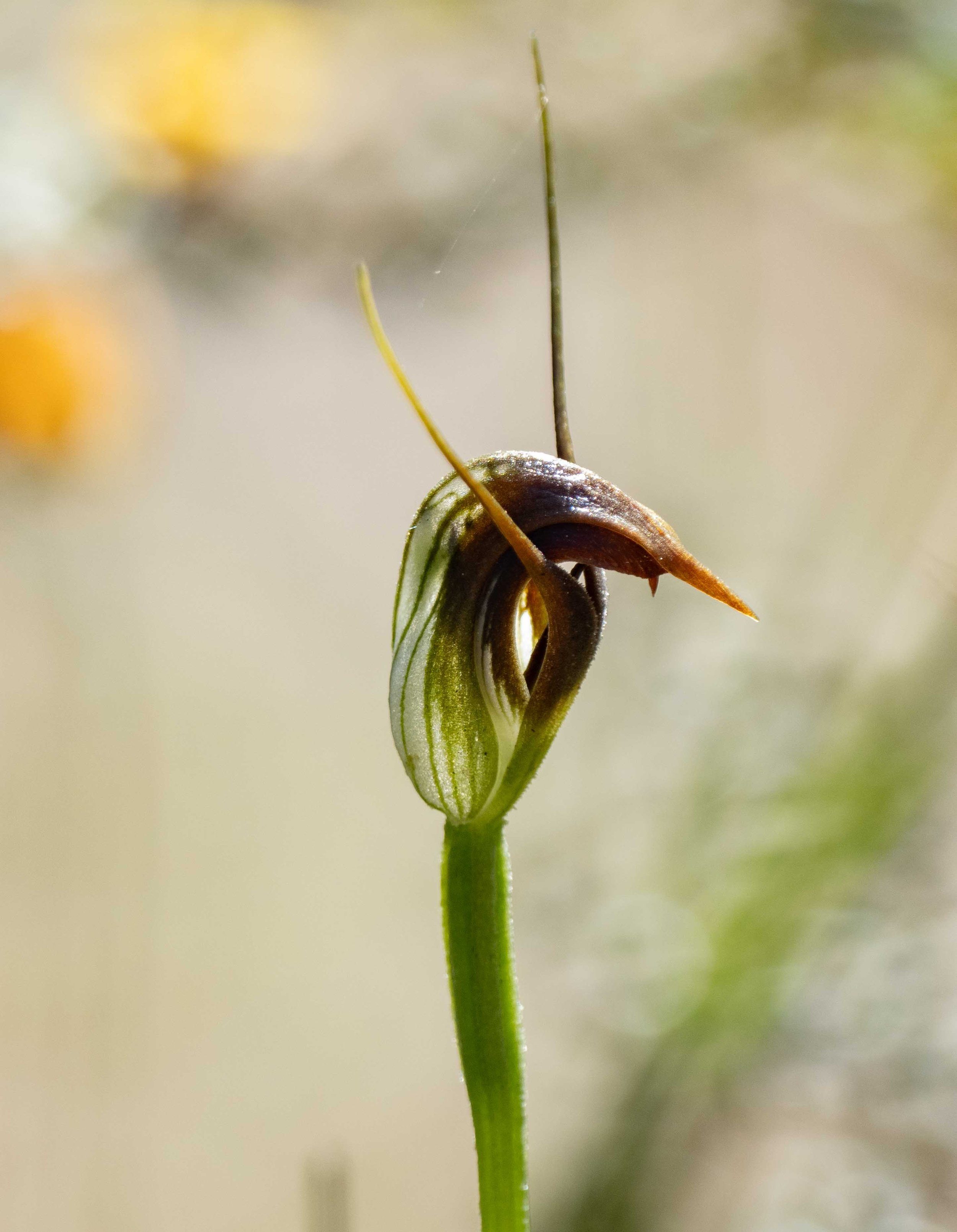
a second spring orchid
A small group of Maroonhoods herald the official start of spring, flowering in their usual spot.
Pterostylis pedunculata (link to iNaturalist record)
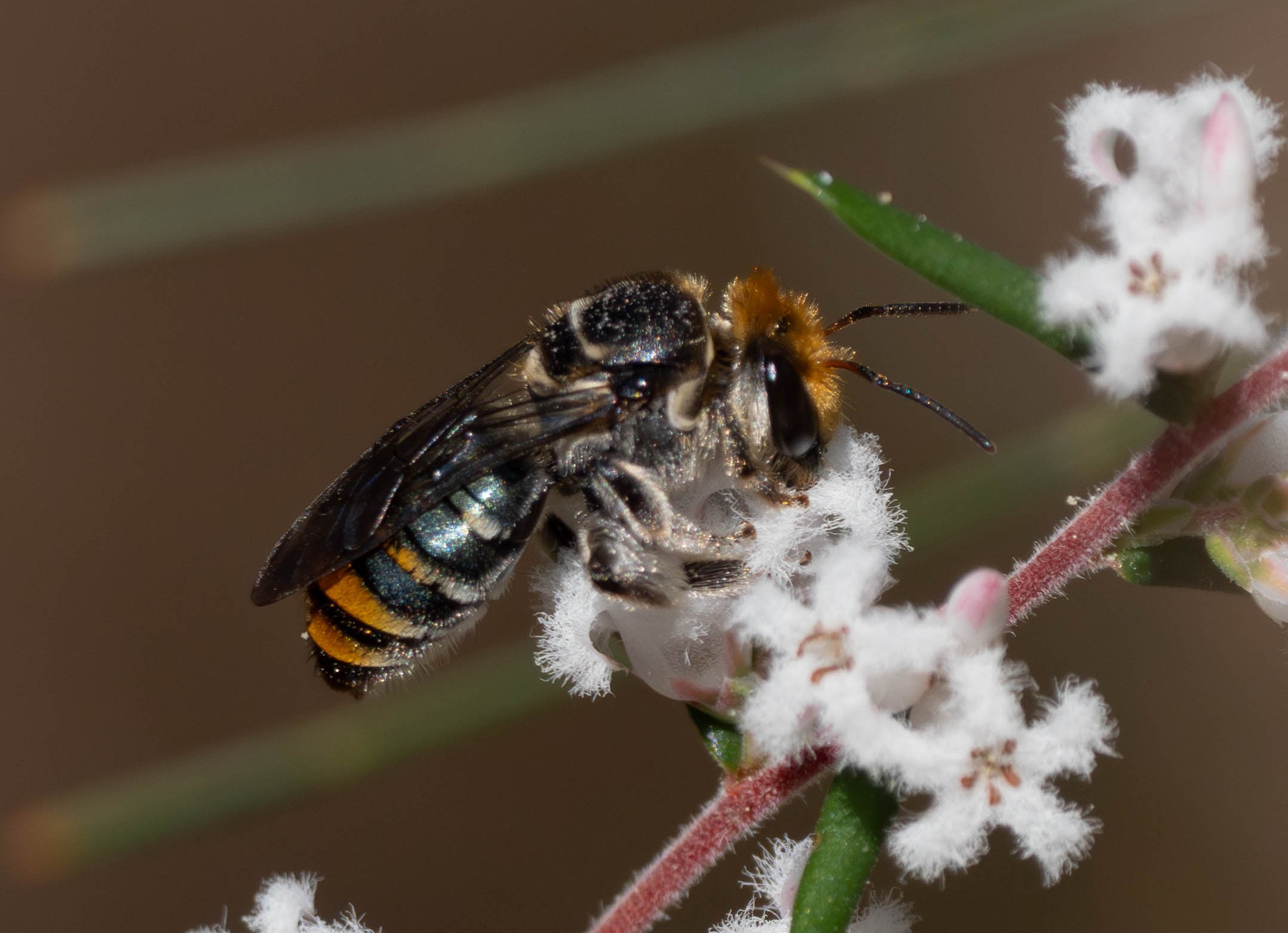
another seasonal first
Green-and-gold Nomia Bees are large, colourful ... and photogenic. This is the first I've seen this season, but I expect they will be a regular sight throughout spring and summer. They're ground-nesters, and I know at least one of their favoured nesting grounds. And they feed on a wide range of flowers. I know where to look for them!
Lipotriches australica (link to iNaturalist record)
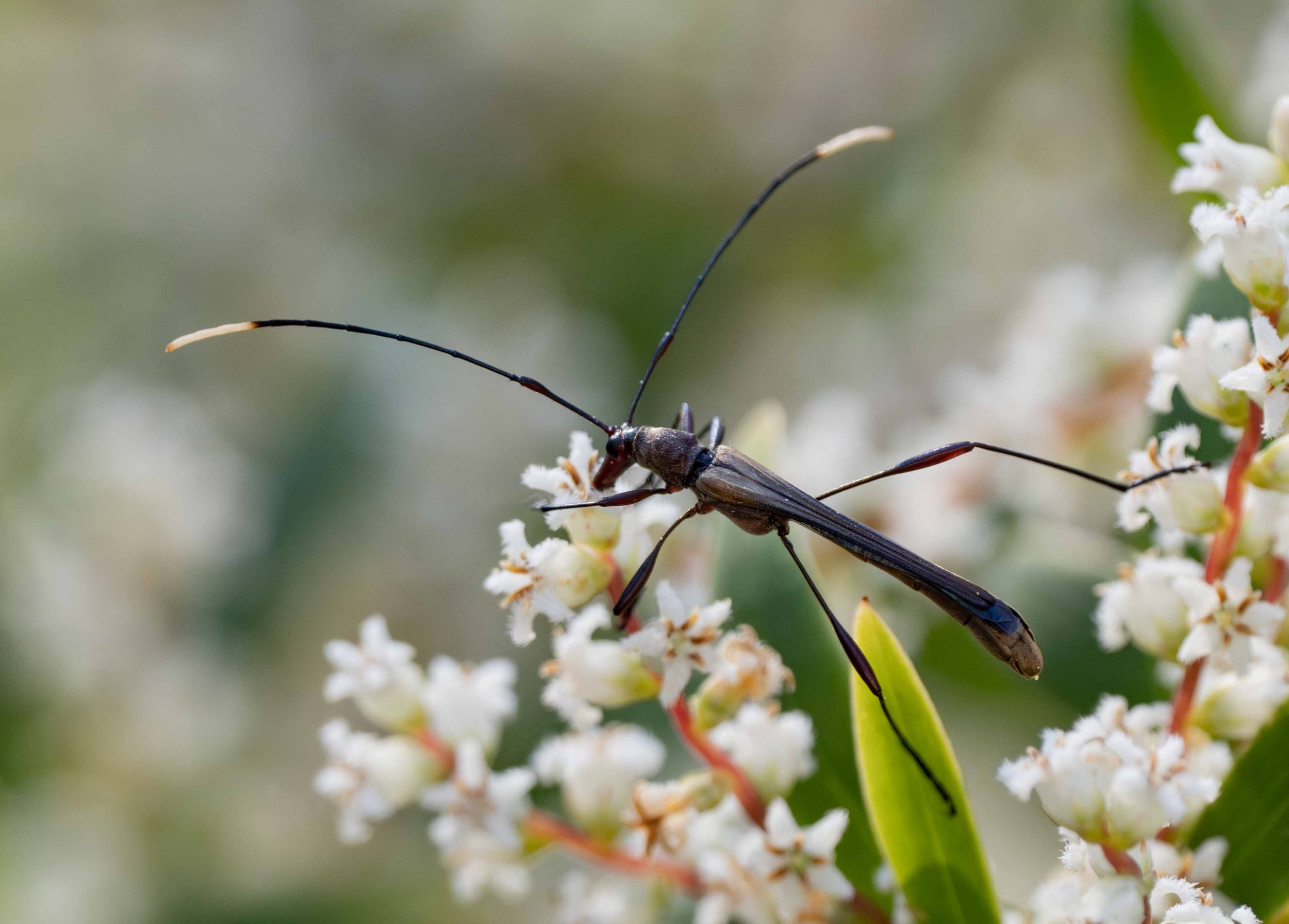
wasp-mimicking beetle
These longhorn beetles are rather comical, with their dragon-like faces and gangly legs. They gather and feed at a range of flowers, including this Leucopogon bush. The host plants for Enchoptera larvae are unknown.
Enchoptera apicalis (link to iNaturalist record)
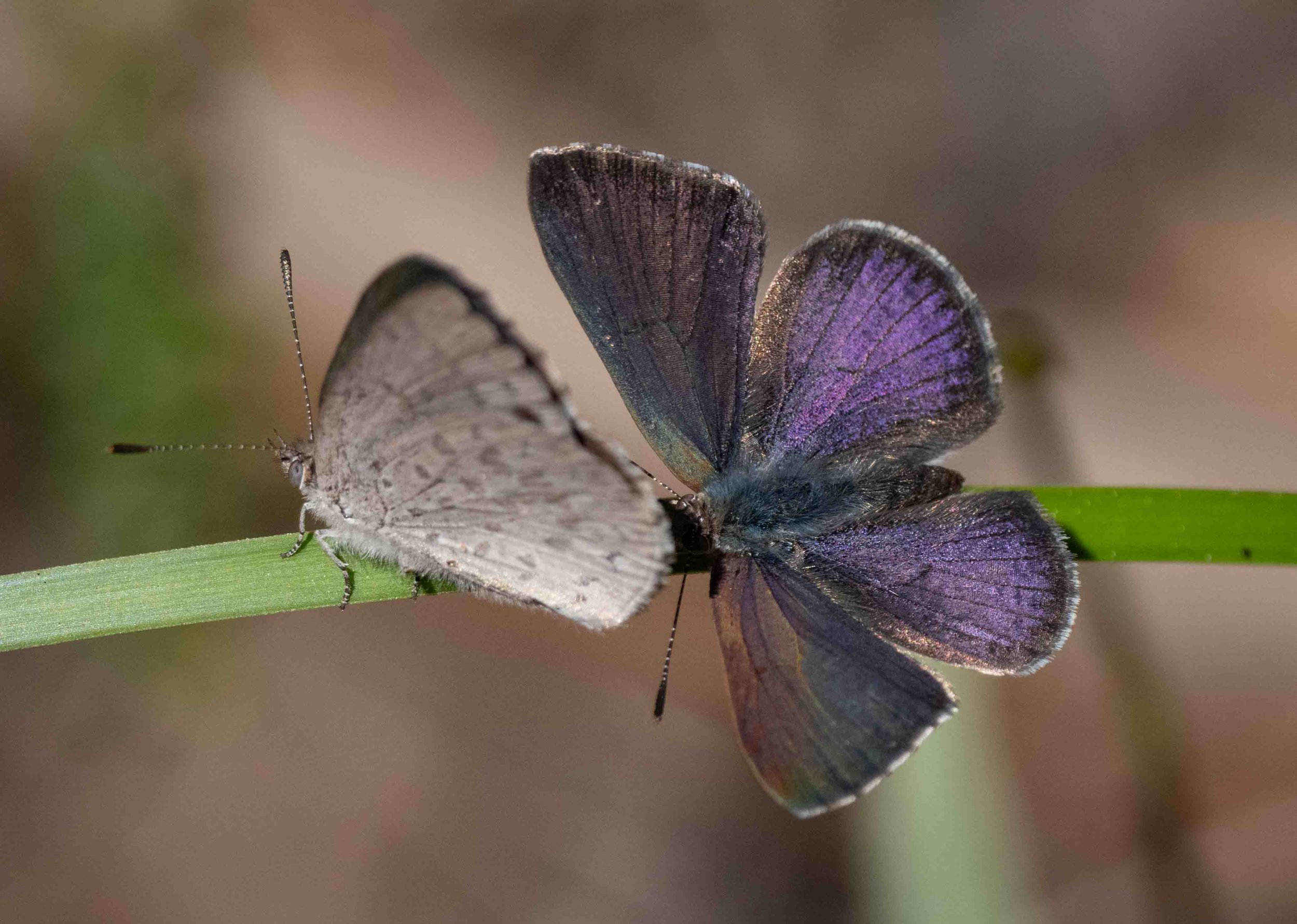
amorous butterflies
It begins with pursuit, then a furious fluttering of wings. The shape of the forewing marks the one on the right as the male. That, and his behaviour ... he is the obvious pursuer.
Erina hyacinthina (link to iNaturalist record)
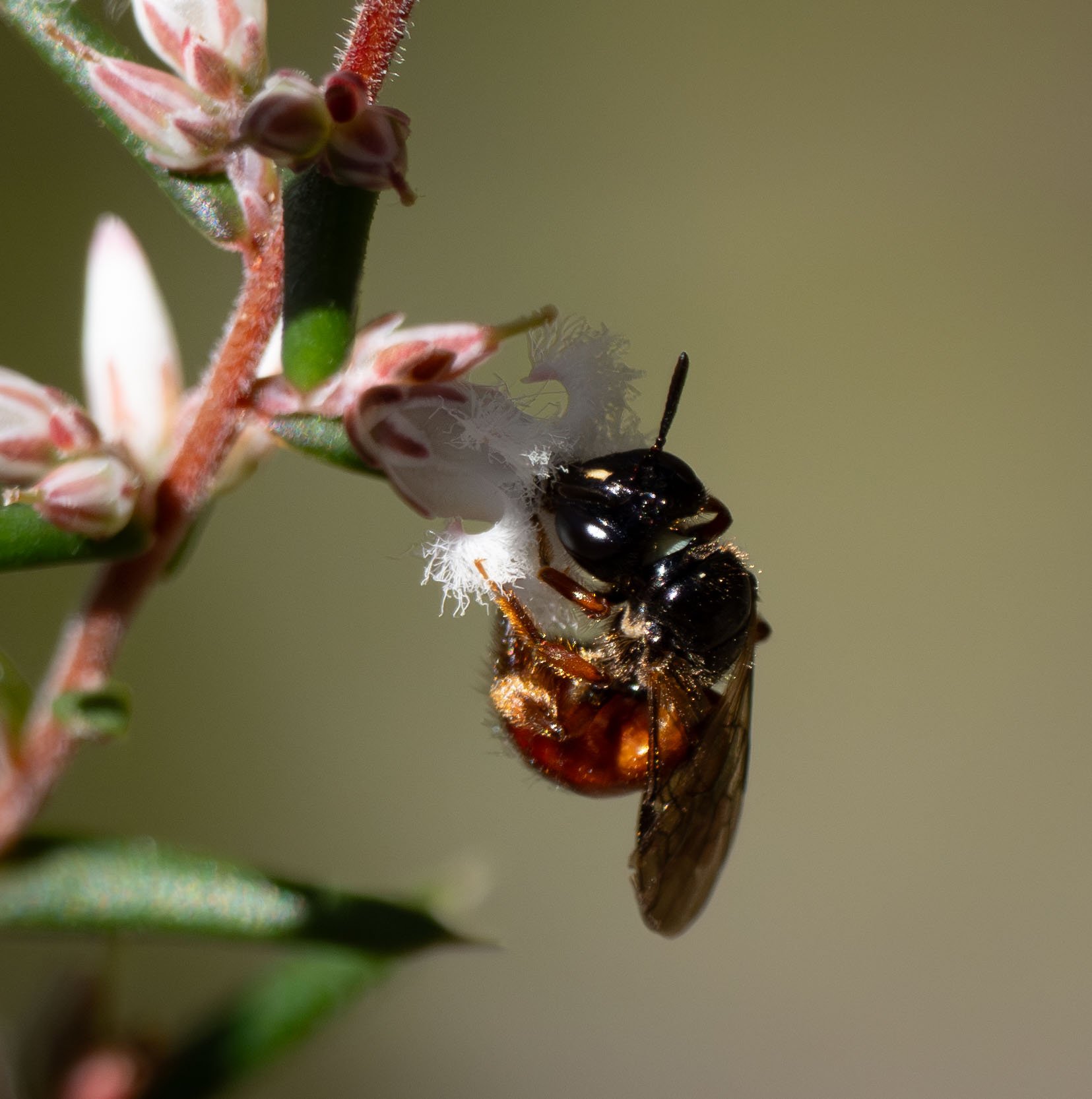
Exoneura
One week into spring, officially, and Styphelia ericoides is already past its prime. Fruits are now forming in the wake of earlier blooms. Yet clusters of flowers and buds remain on some plants, and they continue to cater for their share of small bees.
Exoneura sp.
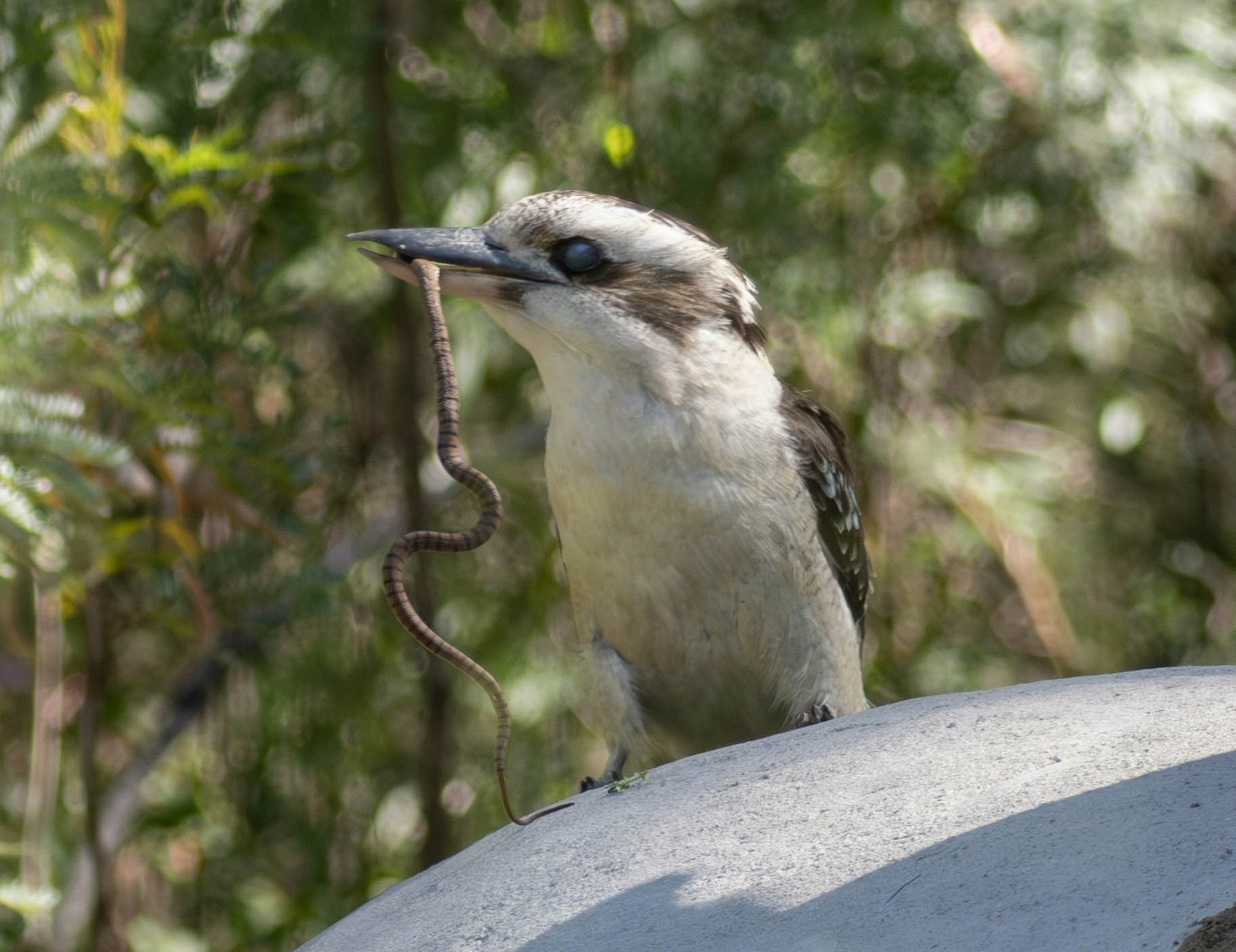
kookaburra 1 : baby snake 0
From atop our bread oven this Kookaburra made a quick dive into the undergrowth and was soon back with its prize: a writhing baby Eastern Brown Snake. Juvenile snakes of this species are readily identified by their stripes and head markings. After bashing it a couple of times on the top of the oven, the winner flew off into a nearby eucalypt.
Pseudonaja textilis (Eastern Brown Snake) (link to iNaturalist record)
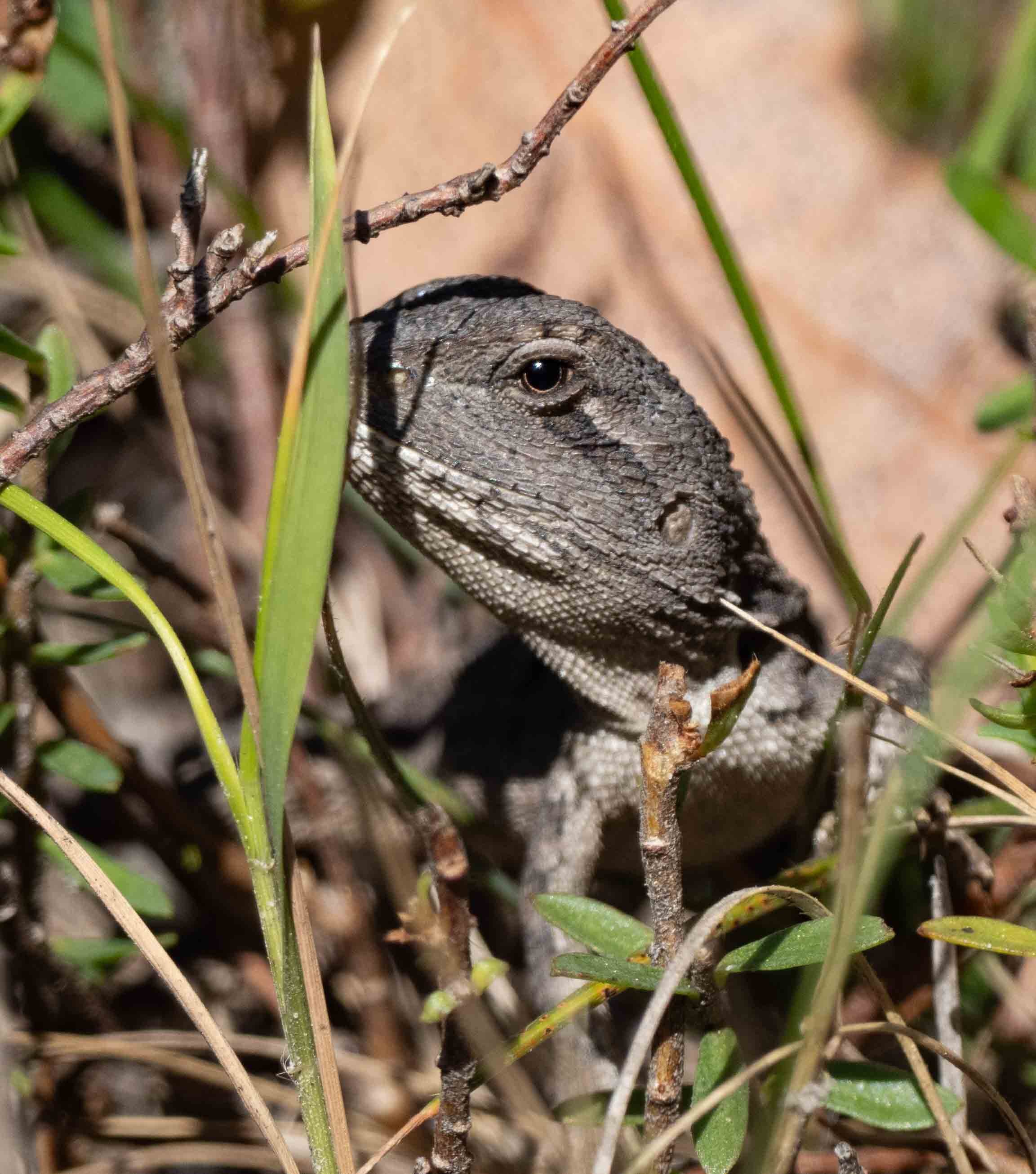
Jacky's back!
This young Jacky Dragon is the first we've seen since the January 2020 fire. Why this should be, we don't know. They were numerous and obvious before the fire. Anyway, it is nice to have them back. They'll just need to beware hunting Kookaburras!
Amphibolurus muricatus (link to iNaturalist record)
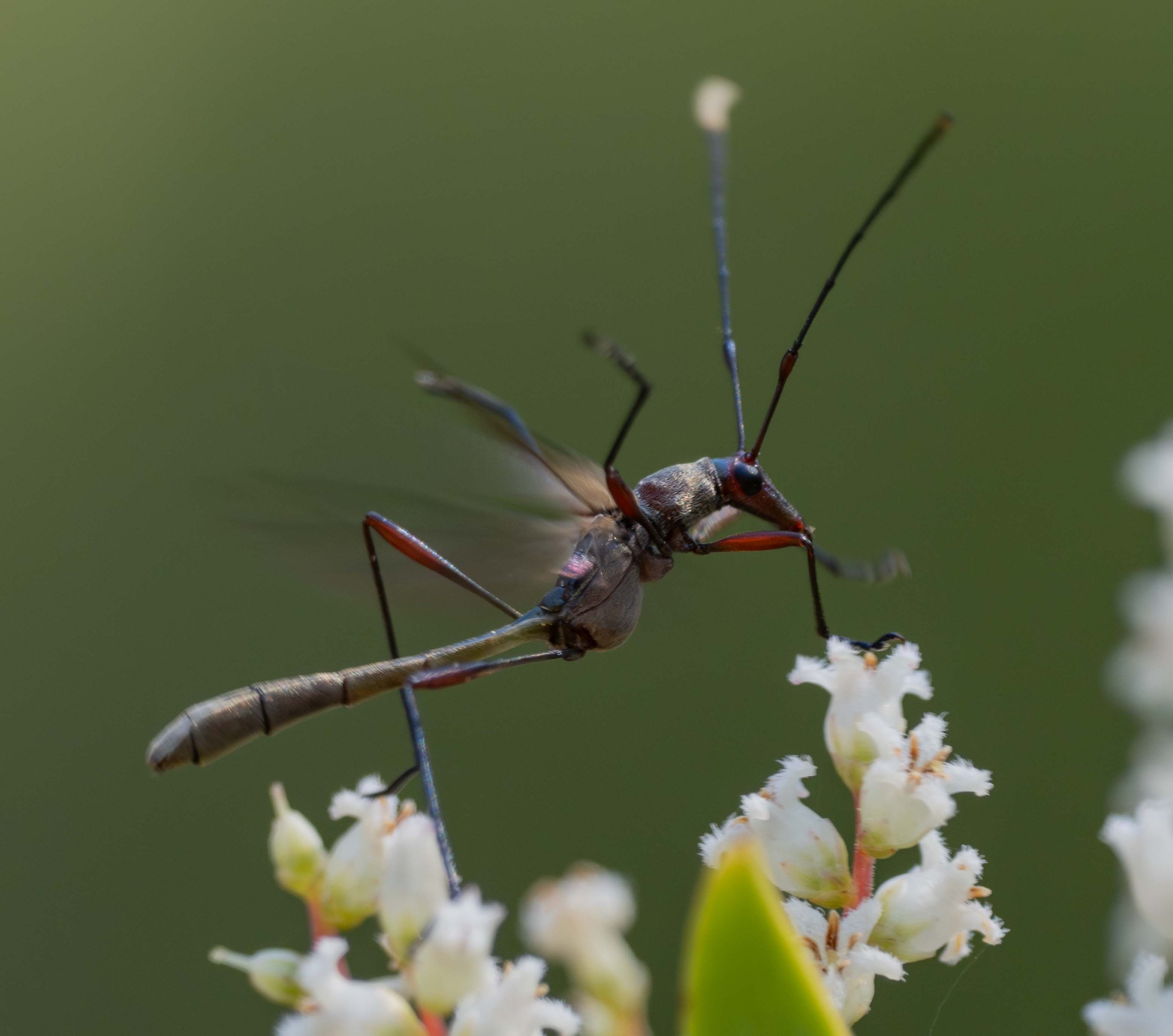
those wasp mimics again
Still hanging about the Leucopogon flowers. Still making me smile with their antics.
Enchoptera apicalis (link to iNaturalist record)
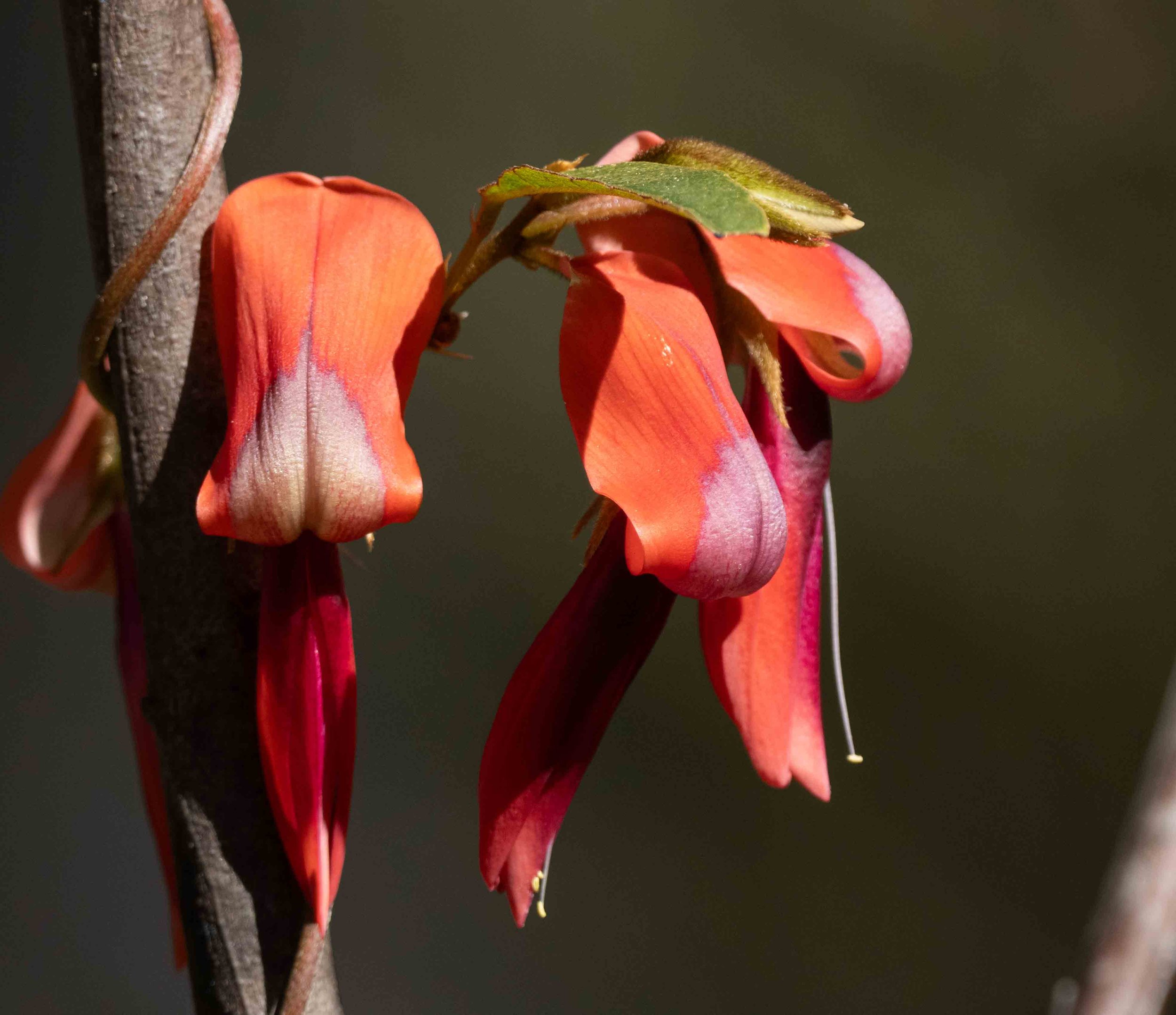
persistent Kennedia
The growth of this tough climber was rampant for a couple of years after the January 2020 fire. Kennedia flowers festooned the standing trunks of dead trees throughout the forest. It has since settled back to pre-fire level, and now just provides decorative touches of colour here and there. Big and red, they're favoured by birds rather than bees. Eastern Spinebills and Yellow-faced Honeyeaters love them!
Kennedia rubicunda
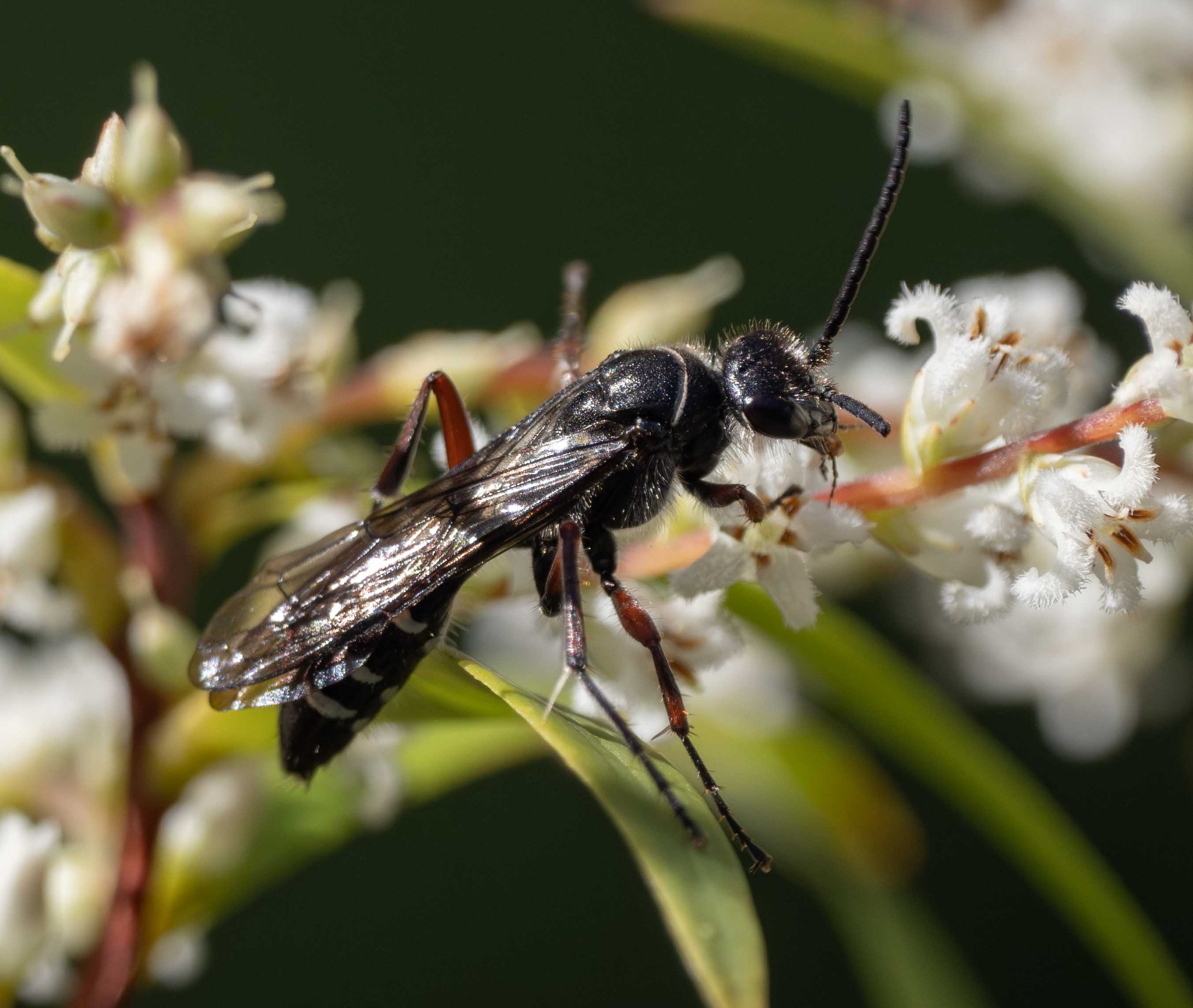
the elusive male 'Blue Ant'
Now this was a nice find! And the second sighting within two days (both times on this Leucopogon bush, so perhaps it was the same wasp each time). 'Blue Ants' ... Diamma bicolor ... are a type of flower wasp. The common name refers to the large, flightless females which are a brilliant blue ... and indeed quite commonly sighted. The males, however, are much smaller, winged ... and very rarely seen! This is only the second time I've photographed one, the previous being in October 2022. And it's not just here that they're a rare sighting. There are over 600 iNaturalist records of this species between Sept 2022 and now ... and only 21 of these are males (including my 2)!
Diamma bicolor (link to iNaturalist record)
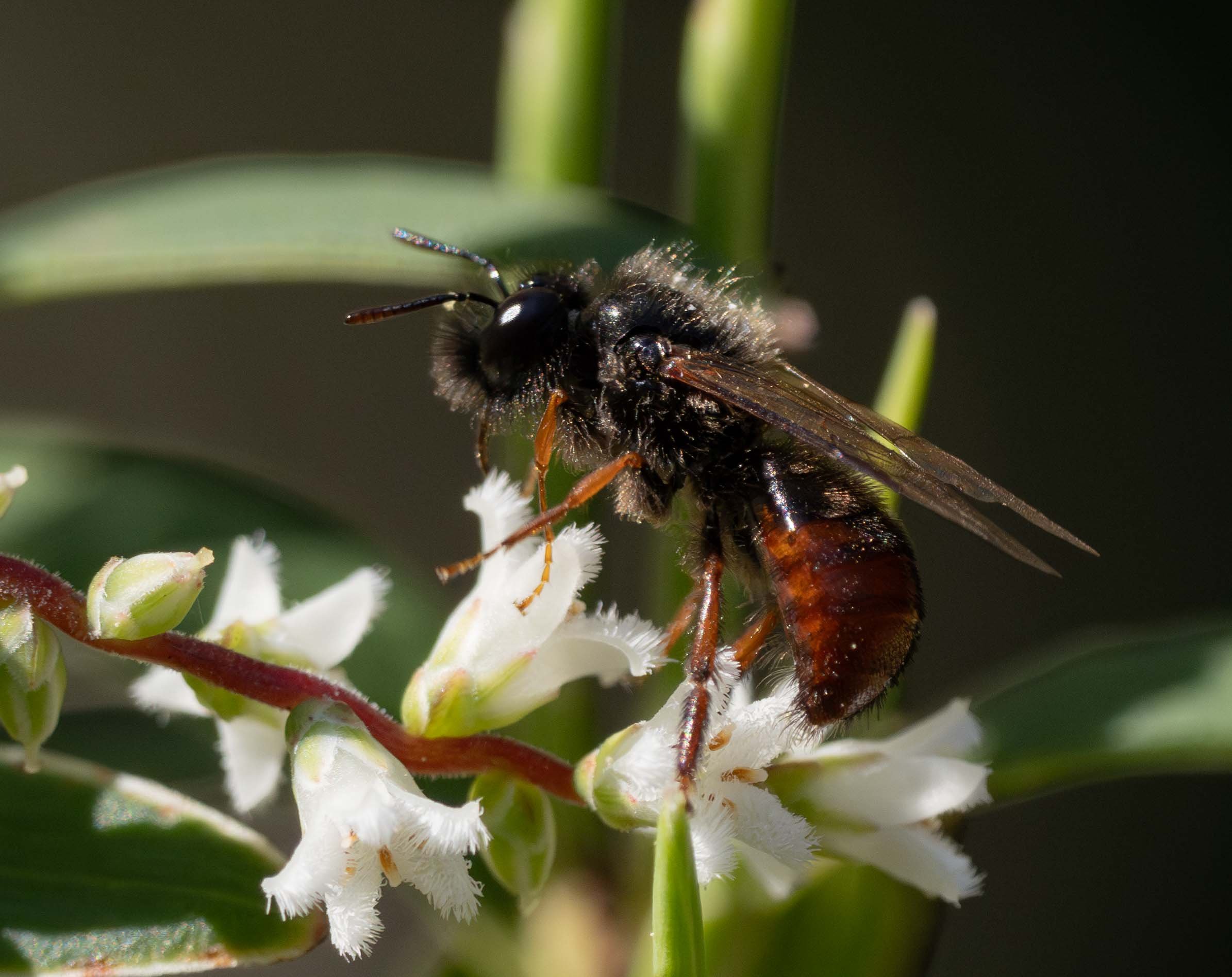
another Exoneura ... but different!
Last spring I spotted these bees for the first time and was puzzled. The apically flattened abdomen is characteristic of Exoneura ... but those huge, bulging eyes and the very hairy face!?! After a bit of research the puzzle was solved ... these features are characteristic of the males of some species within the subgenus Exoneura (Exoneura). And now, almost exactly 12 months later, they make another appearance.
Exoneura robusta (link to iNaturalist record)
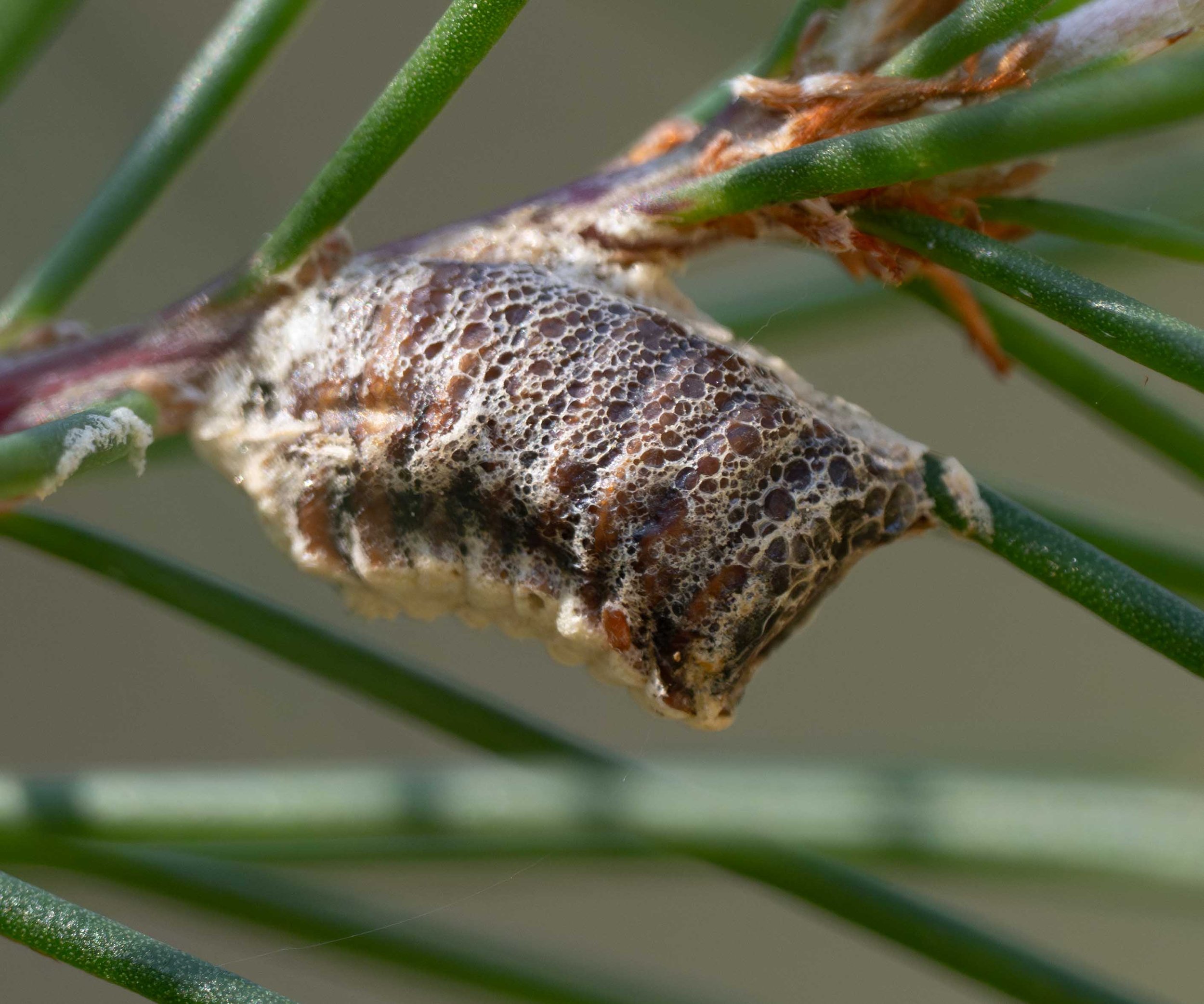
mantid egg case
We rarely spot mantid ('praying mantis') egg cases, which is a little surprising given that we frequently see the insects themselves. Mantids surround their eggs in a frothy material that hardens upon drying and forms the 'ootheca', the shape of which varies between species. Despite the protective ootheca, mantid eggs are often targetted by tiny parasitic wasps. I have decided to bring this one inside to see what eventually emerges ... mantids, wasps, or both!
Orthodera (link to iNaturalist record)
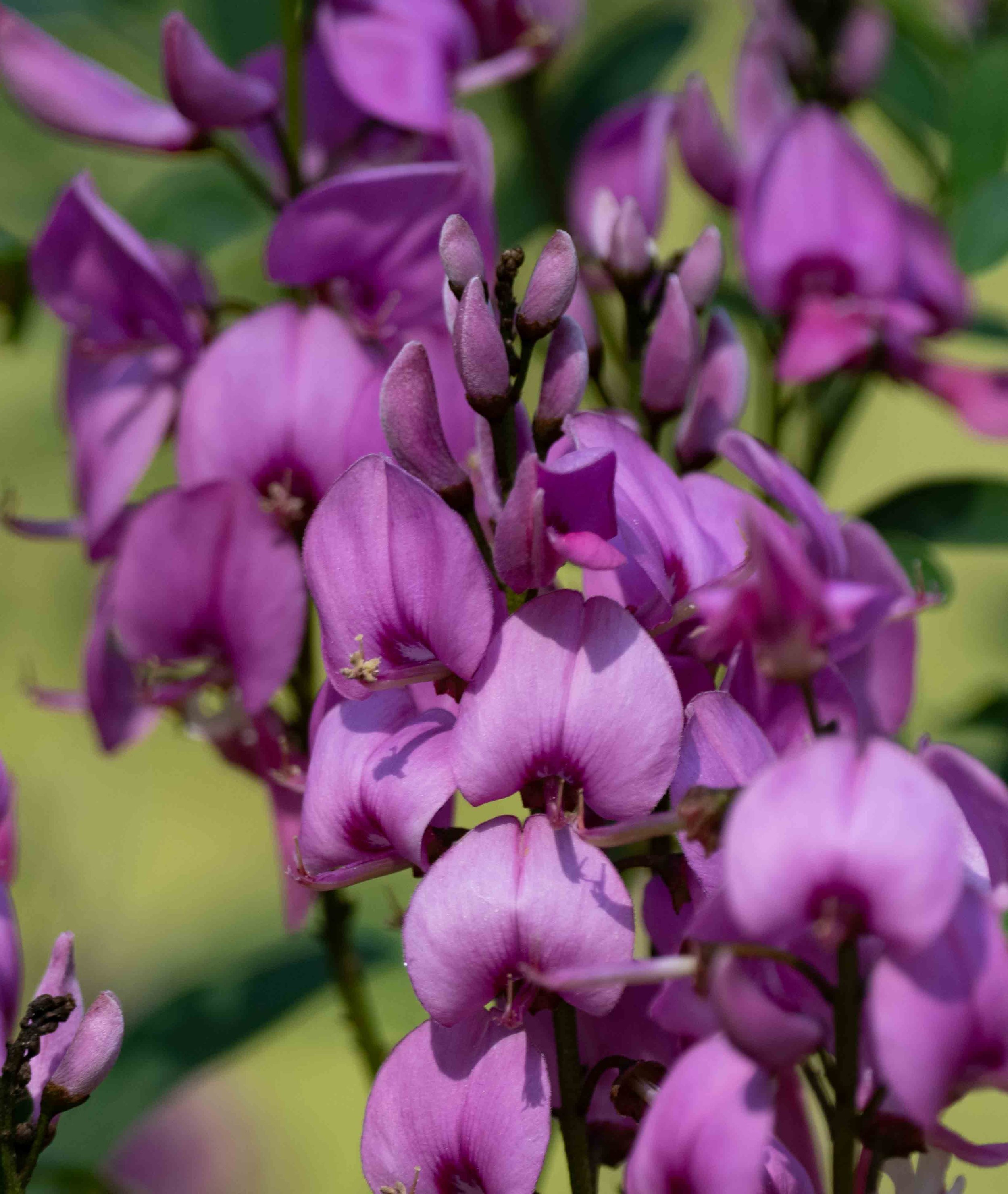
pink peas in profusion
Approaching peak pink, when Austral Indigo adorns the shrub layer with sprays of delicate pea flowers.
Indigofera australis
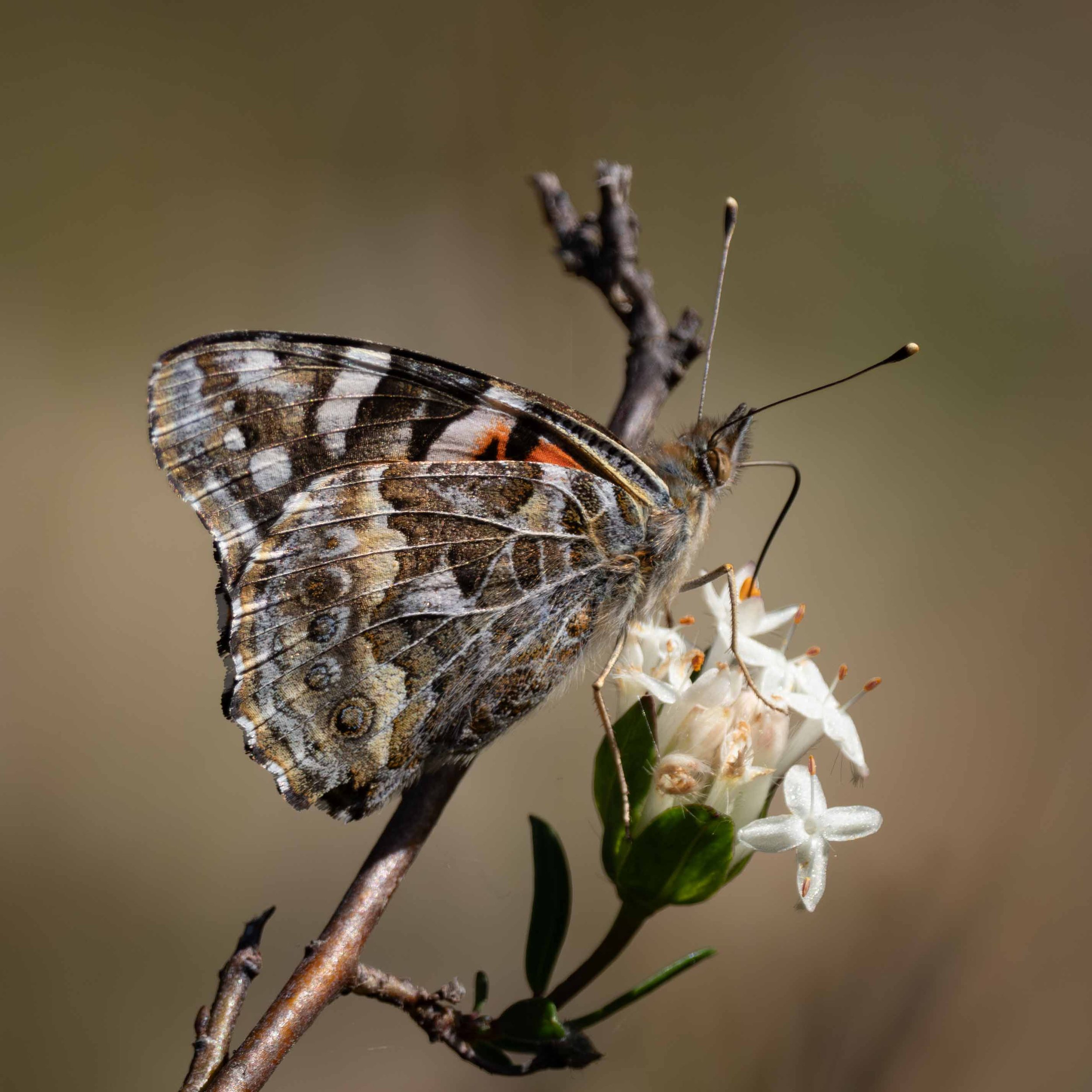
Australian Painted Lady
A widespread and common species ... and yet another butterfly species taking full advantage of its long proboscis to probe the tubular Pimelea flowers.
Vanessa kershawi (link to iNaturalist record)
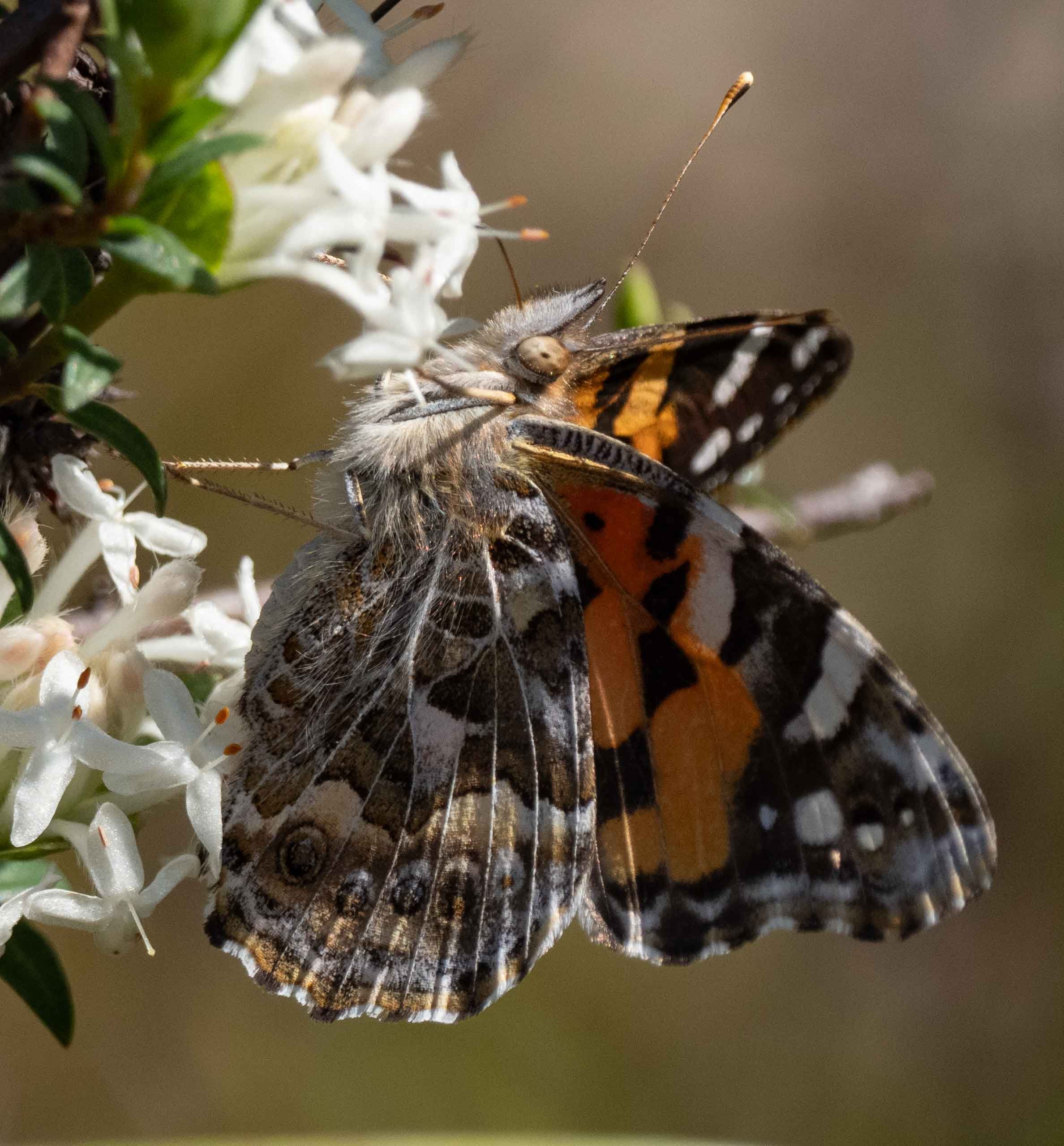
a tapestry of wing scales
The lower surface of their wings are even more decorative than the upper.
Vanessa kershawi
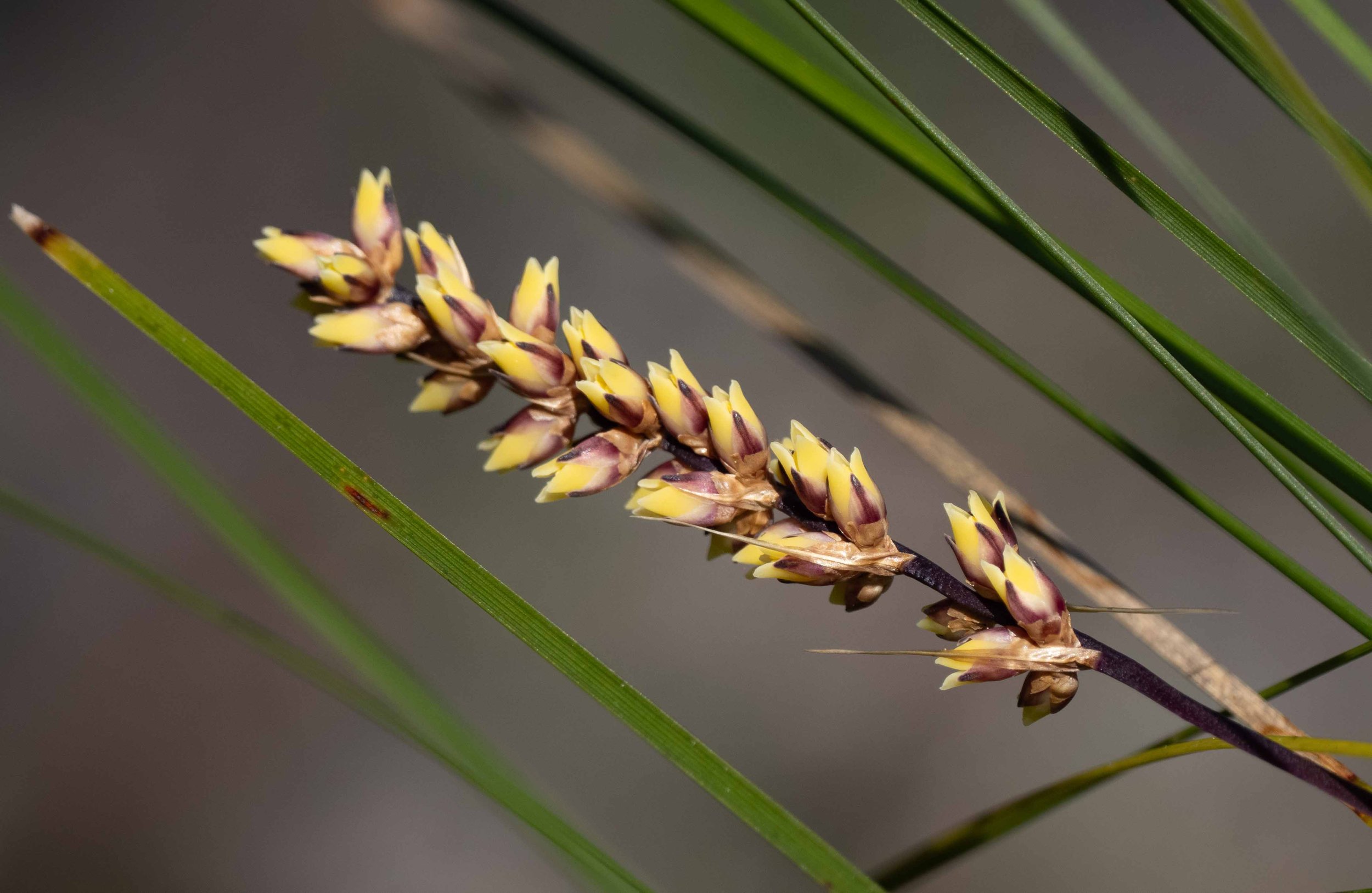
Lomandra flowers
The tussock of green leaves is rather grass-like, but this is not a grass. Lomandra ('mat rushes') are hardy, adaptable, perennial ... and therefore well-suited to public spaces where they are widely used as both decoration and erosion control. This is one of five Lomandra species on our home list.
Lomandra confertifolia
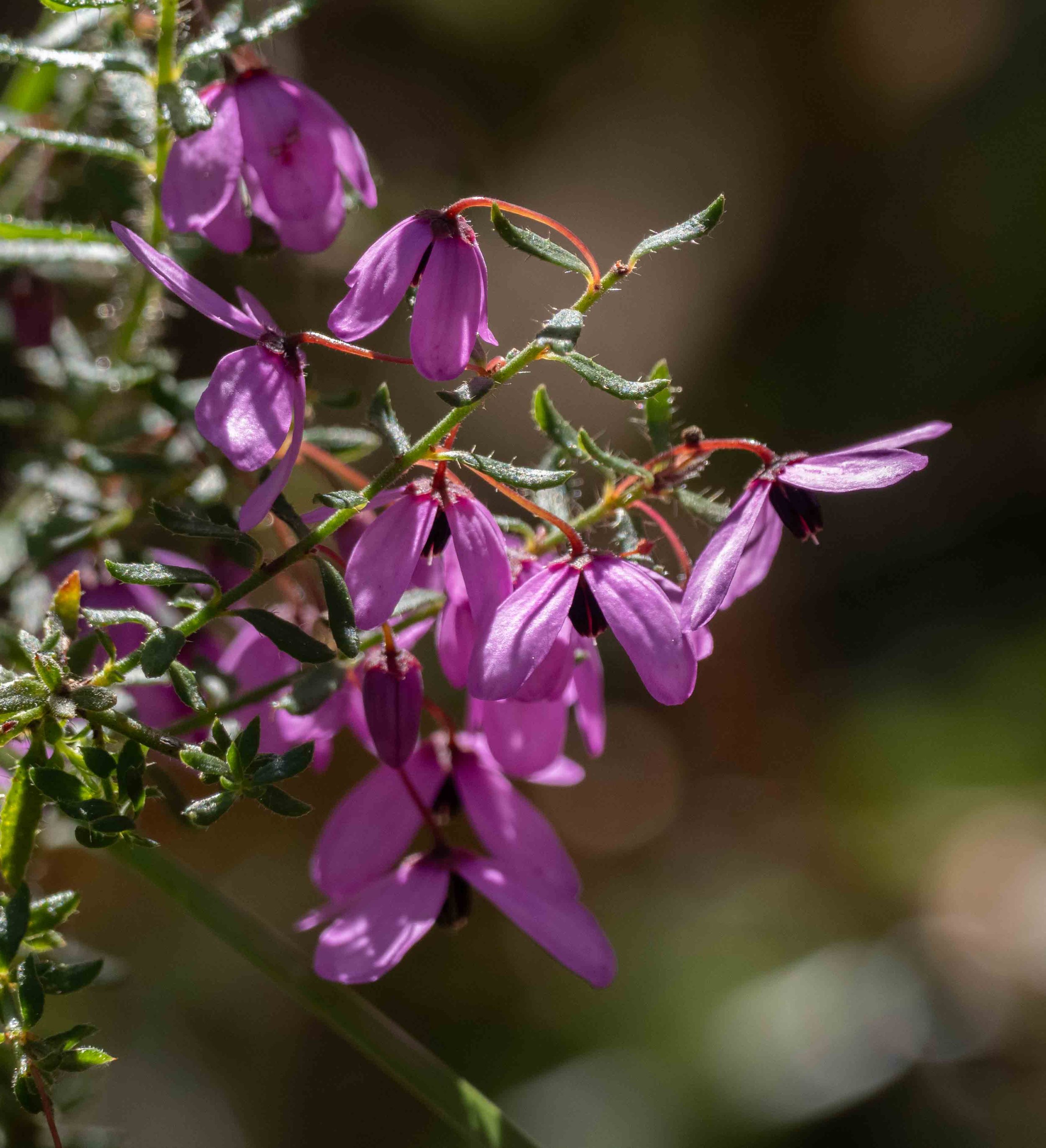
pink-bells
Tetratheca grows well on our sandy, nutrient-poor soils. It is a plant of heath and sclerophyll forest in southern parts of Australia. Indeed, we are nearly at this species' northern limit for NSW!
Tetratheca pilosa
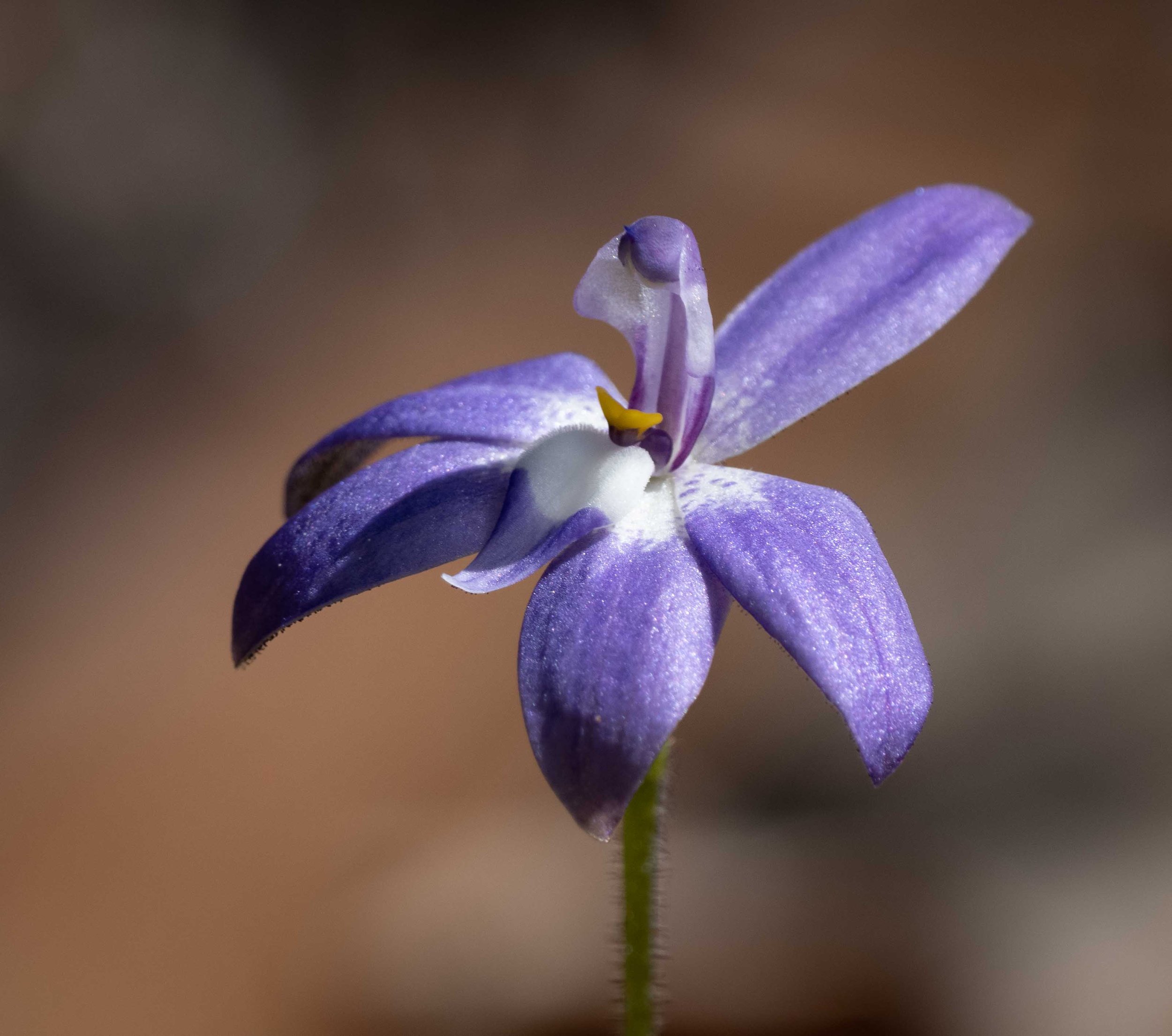
Wax-lip Orchid
Another orchid makes its first appearance for the season. So far just a handful of blooms, but it really does look like we're in for a good orchid show this spring!
Glossodia major (now Caladenia major) (link to iNaturalist record)
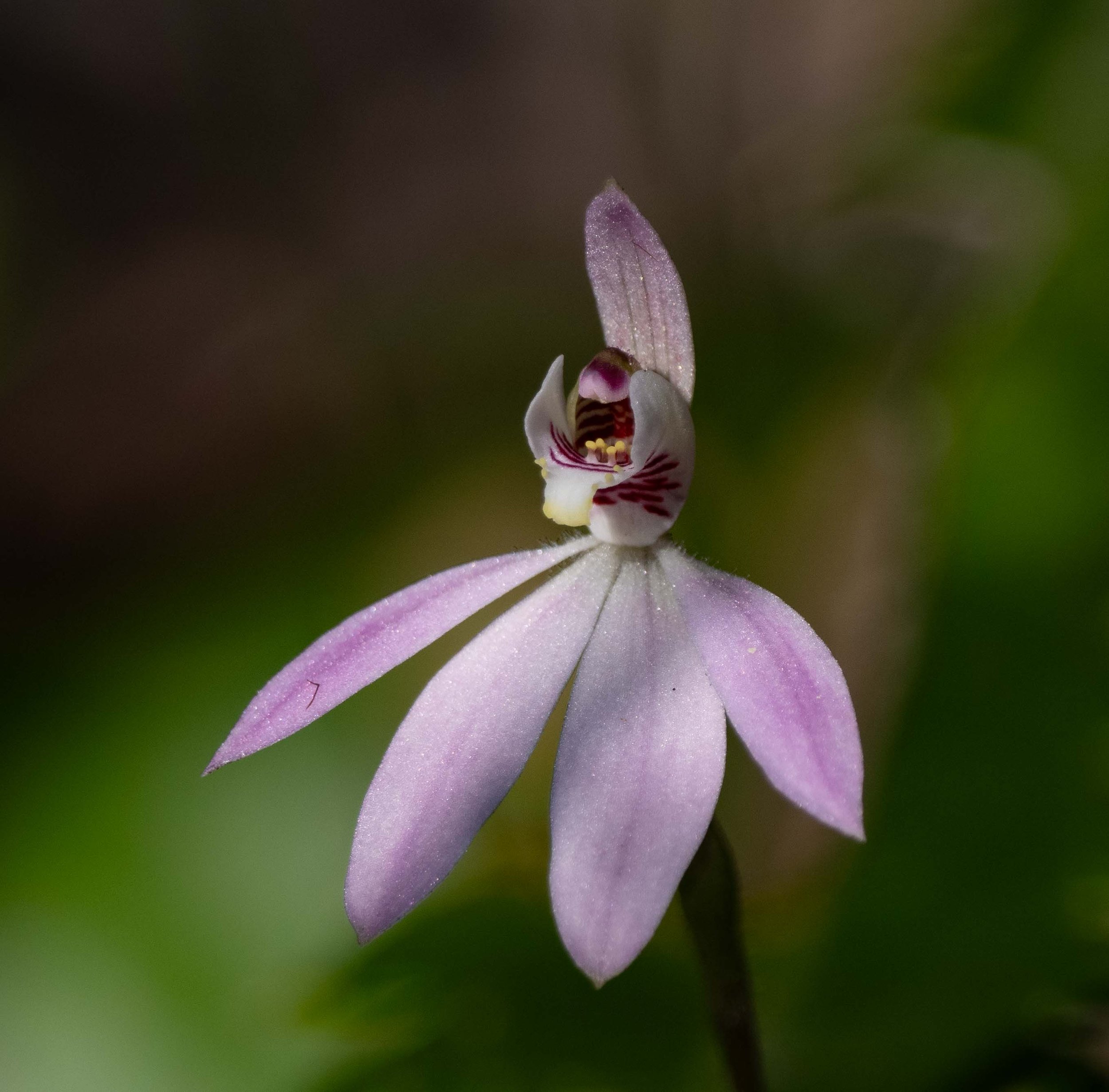
lots of little pink orchids
Small pink to white orchids of this type are common and widespread ... and rather difficult to confidently take to species level. This one does appear to be Caladenia carnea, but among the growing number of flowers appearing we may also have C. fuscata. The differences are subtle ... largely coming down to the intensity of the pink.
Caladenia carnea
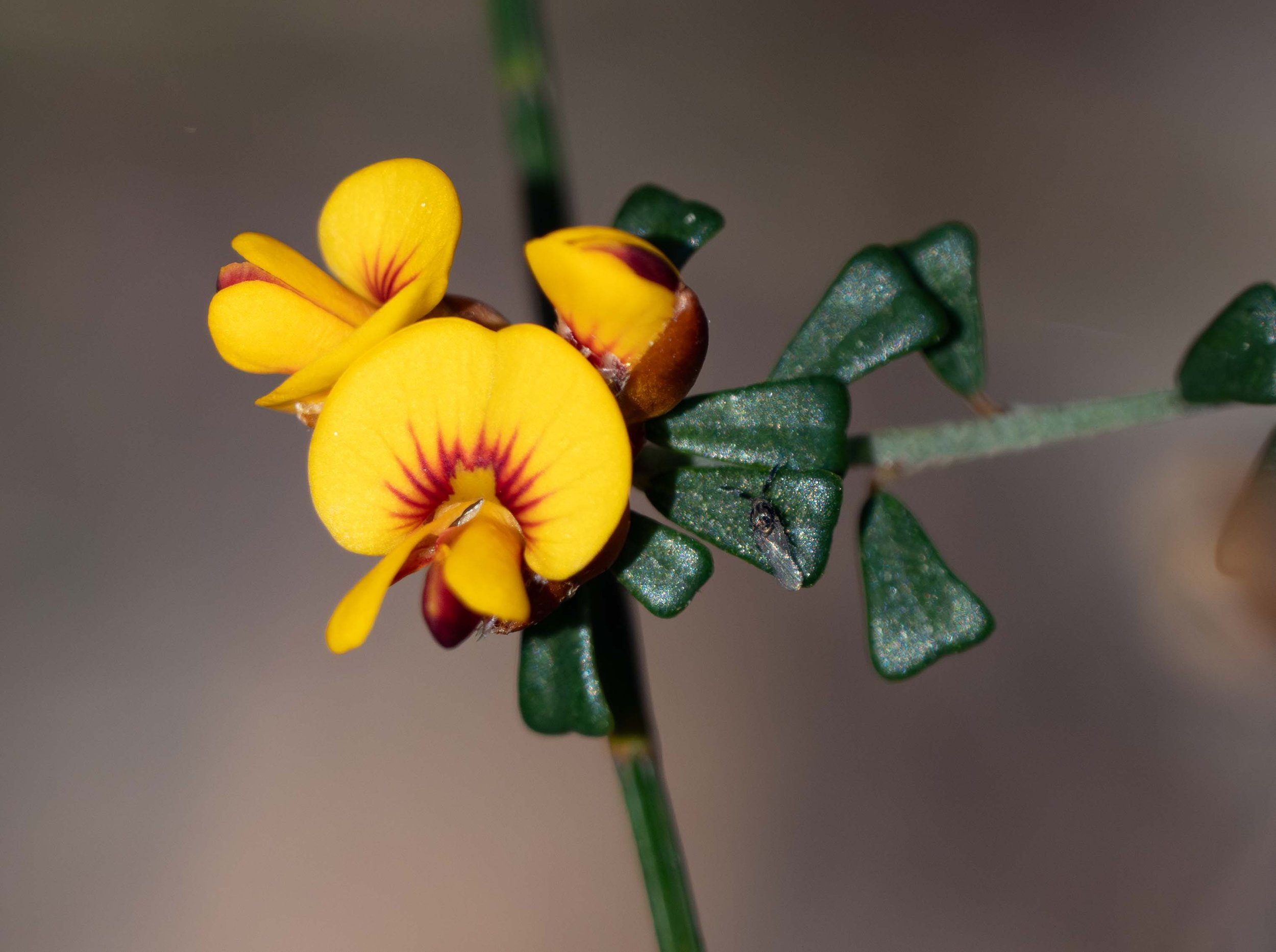
another Bush-pea
The genus is reportedly under revision, so names and groupings may change. For now, this is the third of our Pultenaea species to flower this spring.
Pultenaea retusa (link to iNaturalist record)
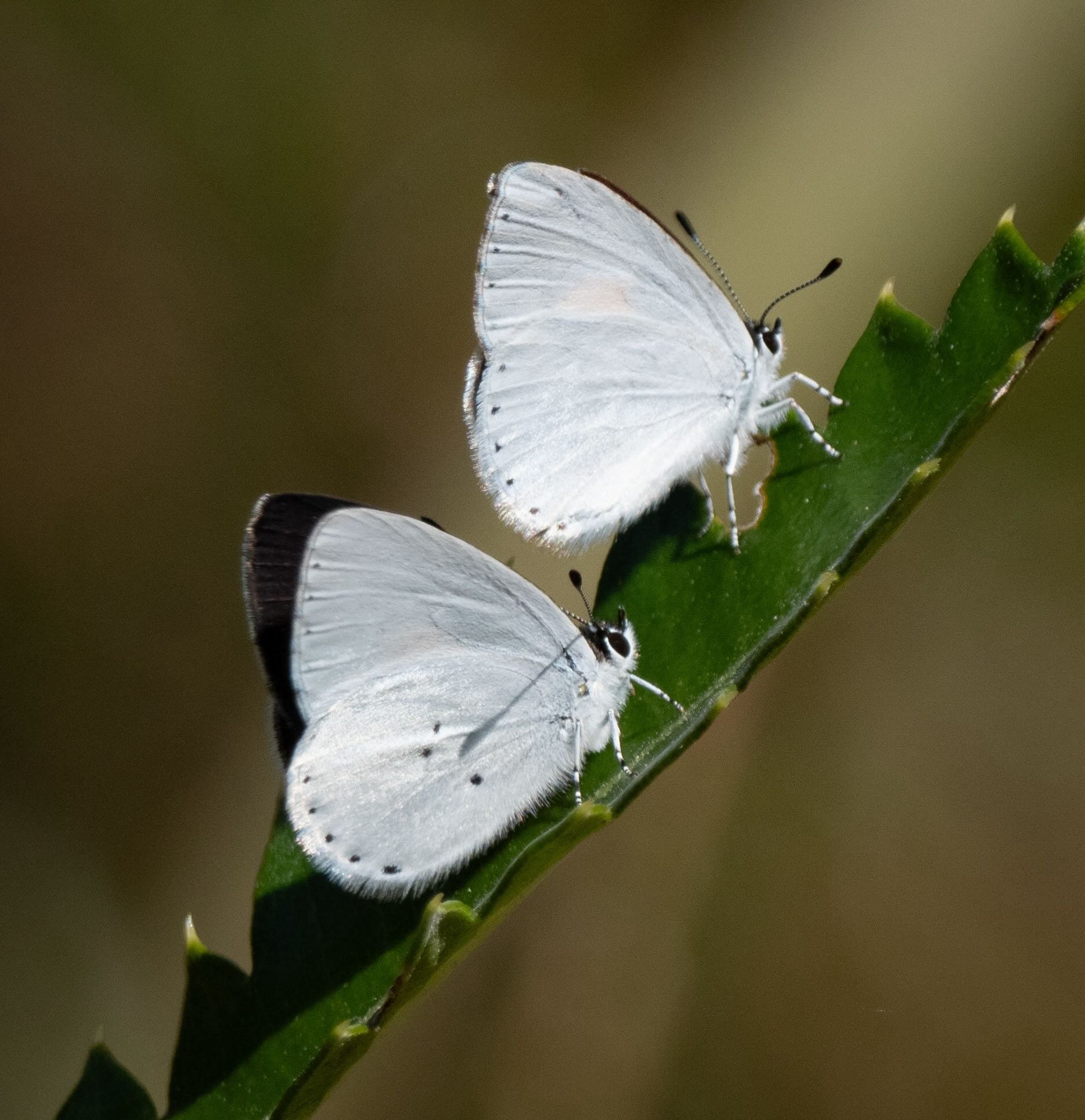
Yellow-spotted Blues
Suddenly these small, brilliantly white butterflies appear in numbers ... and quickly set about finding mates. Just seconds after this shot the pair where securely coupled, end-to-end.
Candalides xanthospilos (link to iNaturalist record)
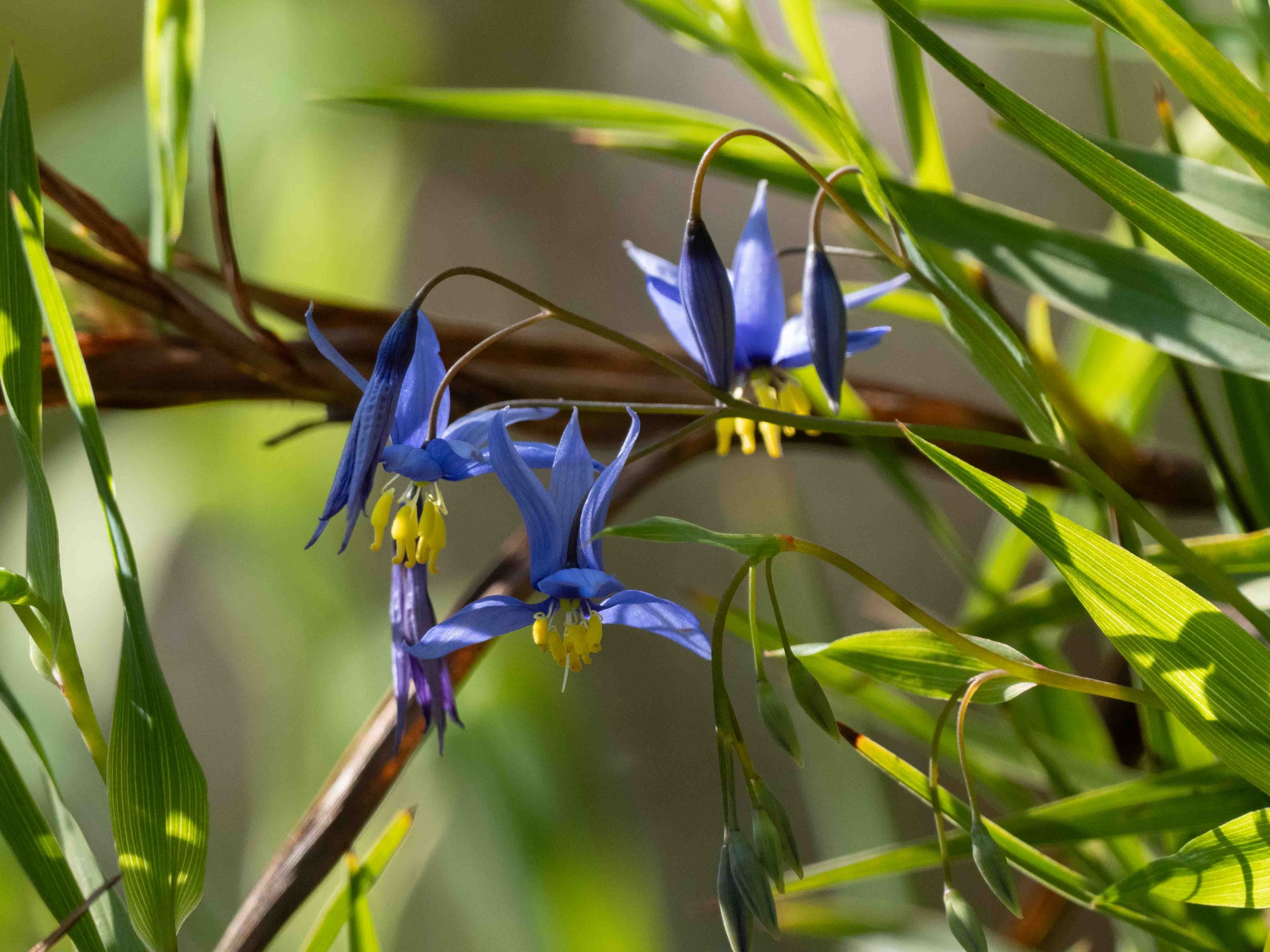
blue lilies
More flowers appear, this time in dense swathes on the steep slope leading down to the river. The species does well in sandy or granitic soils and full sun, and these lilies are widespread across eastern NSW and southern Australia. I'll be checking the flowers regularly for insect visitors ... several of our bee species are quite adept at clinging upside down to the dangling anthers!
Stypandra glauca (link to iNaturalist record)
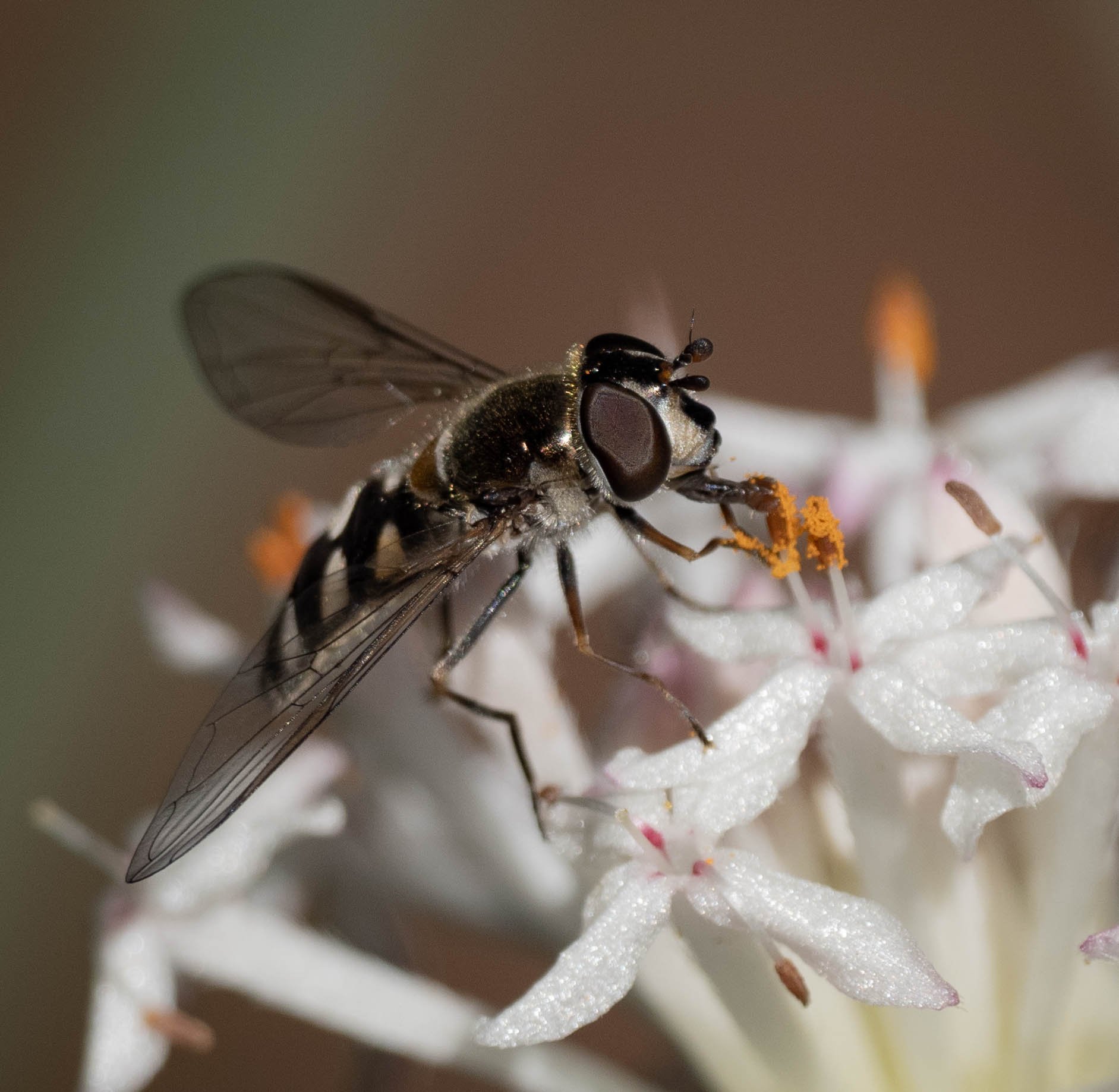
pollen feeding
Hoverflies consume both pollen and nectar. The exposed anthers of Pimelea flowers are readily accessible to these short-tongued flies.
Melangyna (link to iNaturalist record)
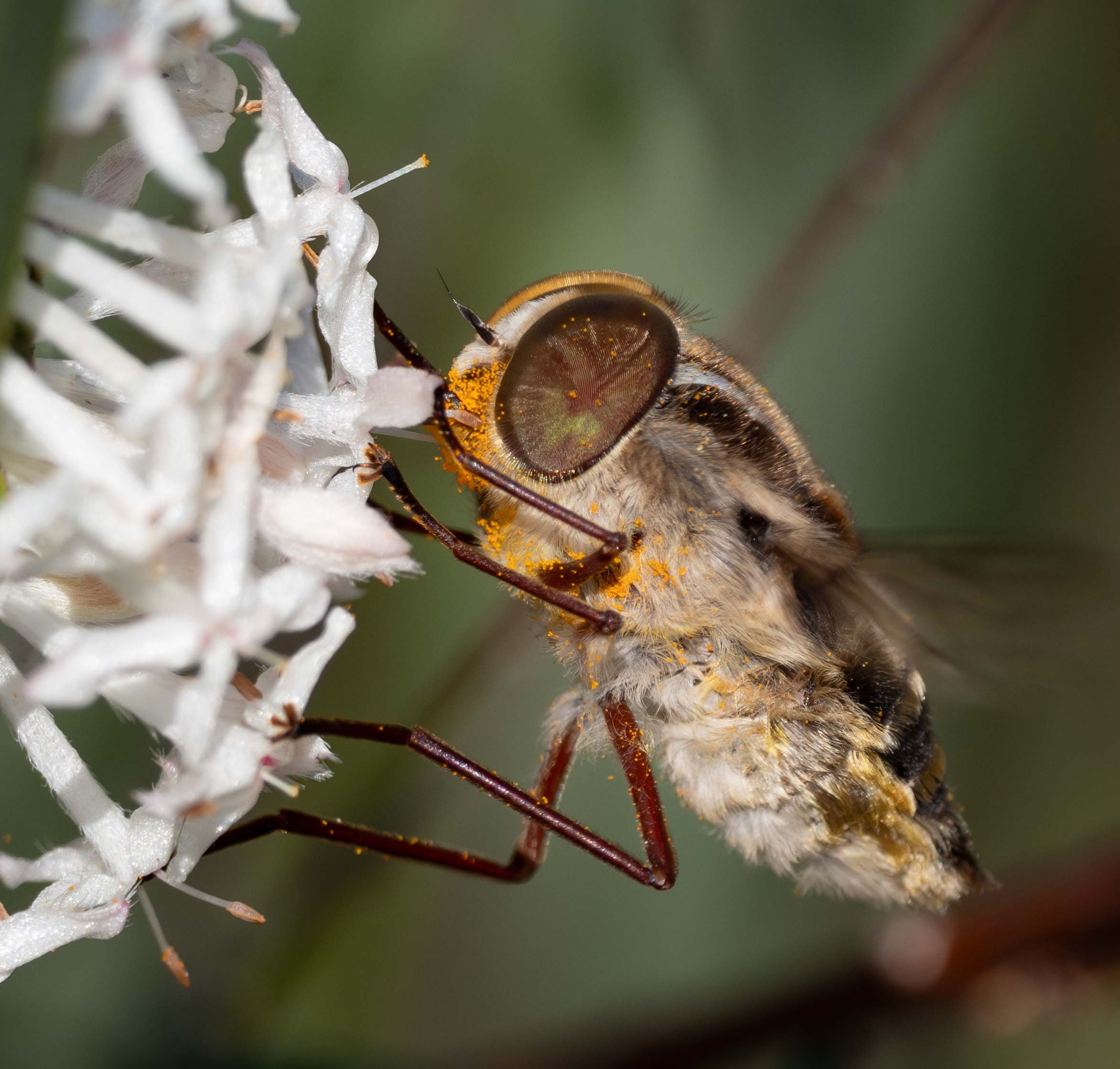
effective pollinators
What makes an insect an effective pollinator? Quite simply, it must move between flowers of the same species ... and it must transport pollen. This tangleveined fly (Nemestrinidae) no doubt has the potential to be an excellent pollinator of Pimelea! The bright orange pollen grains cling to its hairy body, as it progressively works from flower to flower, plant to plant. However, unlike hoverflies, tangleveined flies are rarely numerous ... the hoverflies, bees and butterflies no doubt play a more significant role for our local Pimelea population.
Trichophthalma laetilinea (link to iNaturalist record)
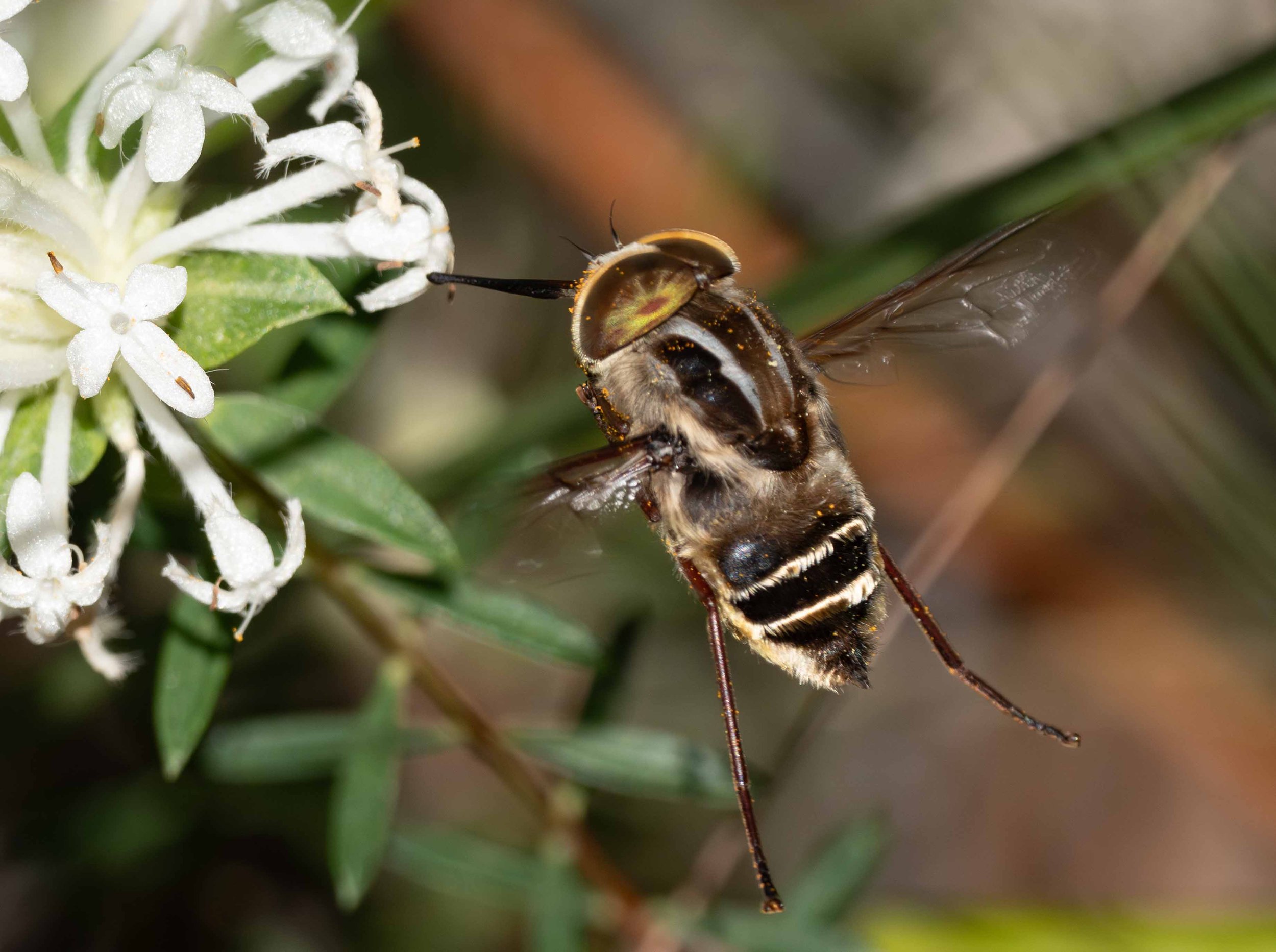
an impressive probosics
The very long mouthparts give this fly an advantage over hoverflies. Like the butterflies, and in stark contrast to hoverflies, Trichophthalma can reach the nectar which is held deep within the floral tube.
Trichophthalma laetilinea (link to iNaturalist record)

a momentous flowering
Of all the plants to begin flowering in the last month, this is certainly the most exciting for us! These attractive, tall shrubs with their drooping branches are not common in our region. Indeed, we are almost at their southern limit. The species is killed by fire and relies upon the post-burn release of seeds from its woody fruit to recolonise an area. We recorded the first seedlings three months post fire ... and on 31st August this year we celebrated the first flowering of some of those young shrubs!
Hakea macraeana (link to iNaturalist record of first flowers opening)
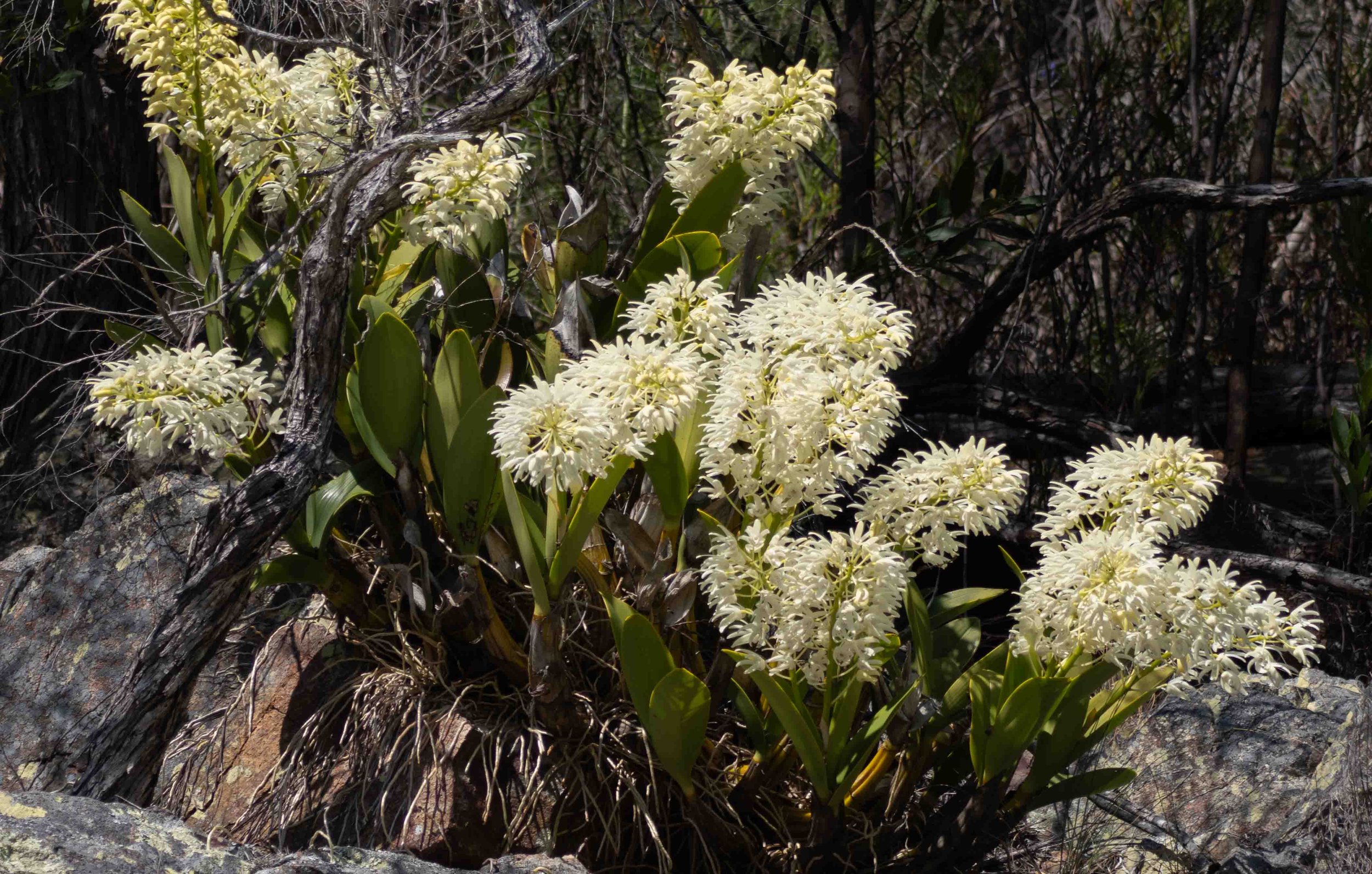
another floral spectacle
On the rocky cliffside above the river, this orchid survives and thrives. Some years it flowers en masse, other years hardly at all. This year is a great year! Like our Hakea species, we are near the southern limit of distribution of this Rock Orchid. It persists in a few locations in far East Gippland, but "unscrupulous collectors" have pushed the plant to Critically Endangered status in Victoria (link to VicFlora site).
Dendrobium speciosum var. speciosum (link to iNaturalist record)
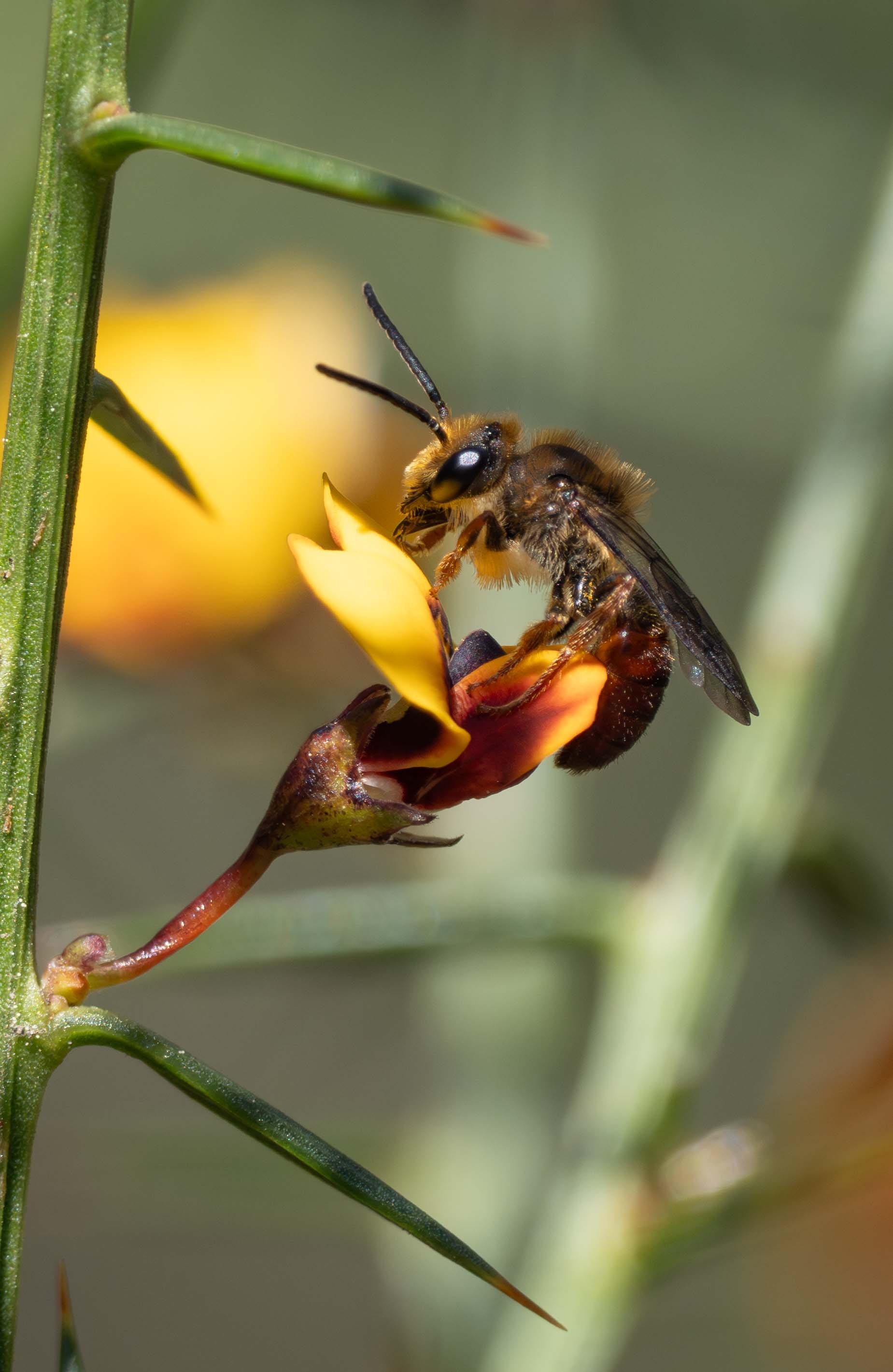
nectar-feeding male bee
A species commonly found on pea flowers, this male Leioproctus was one of many bees swarming about and feeding on a single Daviesia bush. It was quite a spectacle, and included at least two species of Leioproctus plus Trichocolletes orientalis.
Leioproctus platycephalus (link to iNaturalist record)

pollen only
Bright yellow Hibbertia flowers are currently putting on a show to rival that of the nearby yellow peas. However, they appeal to a narrower range of insects because Hibbertia flowers lack nectar. They attract only pollen-gatherers, and the plants' pollen is available to only some insects ... those that can free the grains from the tubular anthers. This small female bee had been doing just that ... gripping the anthers of Hibbertia calycina and giving them a good shake.
Lasioglossum (link to iNaturalist record)





























